

14 October 1066
Harold II is defeated by William the Conqueror, Duke of Normandy so the throne of England passed to the Norman dynasty.
HASTINGS
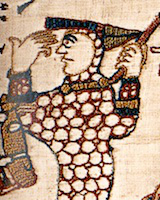
William the Conqueror Son of Robert I, Duke of Normandy, inherited the paternl Duchy at just 8 years and, due to his young age, he lived his first fifteen year of reign challenged, and always under the continuing threat of rival attacks, without being able to prevent riots.
Despite his young age, the balances placed with great effort by his predecessors, proved to be functional, and barely in his twenties, William managed to restore order by returning to Normandy the prestige it once had. It became the most powerful Principality of France, and this allowed him to organize the daring expedition that will allow the conquest of England.
Crowned King of the country in Westminster (December 25, 1066), and renamed the Conqueror, was mainly to establish the real occupation of the island, giving large fiefs to Saxon nobles as to his trust Norman, placing so slowly for the complete feudal structure under one dynasty: the Norman.
Following the same policy, he also reorganized the Church hierarchy by replacing the Archbishop of Canterbury, the Saxon Stigant, with his friend Lanfranc of Pavia, Abbot of St. Etienne. After the Suppression of riots erupted in the northern regions (1075), proved to be a great administrator, achieving important reforms, the most important of which was undoubtedly the Doomesday Book real cadastre of the territories of the Kingdom, unique opera at that time. He died in Rouen for his injuries in another clash with the French.
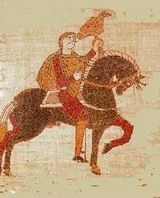
Harold was a son of Godwin, one of the most important figures of the English Court, and maybe is real the fact that Harold himself supported the candidacy and aspirations of William, at first, but later claimed that the dying King had appointed his heir, changing completely "opinion".
At this point the Council of nobles decided to support the claims to the throne of the Saxon noble, indeed, without the approval of the Council of the nobility, even the legitimate heir of a King could be confident the throne. That decision sent him on a rampage William who already felt "the smell" of the Crown of England, and then accused his rival of perjury, ramping up for the military conquest of the country.
Harold died in the battle itself, as is shown by the Bayeux Tapestry, due to an arrow that stuck in the eye.
HASTINGS
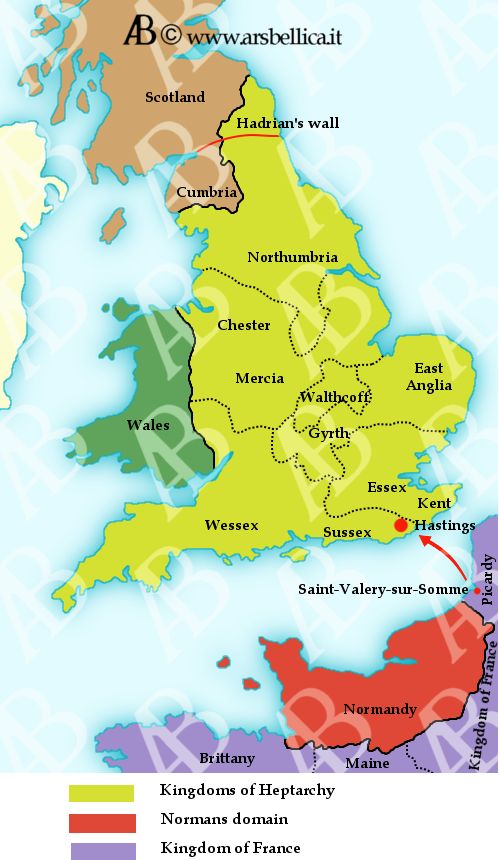
Between 54 and 55 BC, Gaius Julius Caesar made two landings in Britain to punish the local Celtic peoples who had helped the Gauls in their fight against Rome. From that date began the Roman rule in Britain, which will be extended and enhanced by emperors such as Hadrian (who built the vallum as a defense from invasion by Picts and Scots). In later times, the Romans, by order of General Stilicho, had to abandon the island, due to the invasions in Italy (in 408 a.d., after almost five centuries of domination!) of barbarians led by Alaric.
So in 442 the island suffered the invasion of Germanic tribes of Angles and Saxons, mixed with those of the Jutes and Frisians that came from the regions of Jutland and the Rhine. These populations mixed with the Celts and remained Romans in Britain, gave birth to seven small kingdoms often at odds with one another, creating the so-called heptarchy (i.e. the Government of the seven major kingdoms of Great Britain, of which 4 were Angles: Northumbria, Mercia and Kent Eastanglia; while 3 were Saxons: Essex, Wessex and Sussex). Some Britons, however, unwilling to succumb to the Germanic domination decided to move into the Western peninsula of Gaul called Harmonic that, as a result of this appropriation, will be called "Britain".
The perennial conflict between these kingdoms made them weak to external invaders and, in fact, it was very easy for the people as Vikings or Danes prevail on these little kingdoms, until Knut, the son of Scandinavian King Sven, managed to unite under his control England, Denmark and Norway in 1030. Years earlier, however, one of the leaders of those regions of Germanic lineage, Rolf, in 911, obtained from the King of France Charles III the lands of Caux (a region) Evreux and Lisieux (two counties), which for fifty years form the feudal Duchy of Normandy.
In 1042, finally, King Edward the Confessor drove out the Danes from the island and restored an Anglo-Saxon and unified Government. From here onwards the story is very clear William the Conqueror successfully invade England but from that incident onwards this country knew no more, for the rest of the story, any kind of invasion, despite attempts of Napoleonic, Spanish and Germans failed miserably, or remained at the stage of pure design.
HASTINGS
The troops that hastily Harold had managed to mobilize the rest arrived not to clash with the Normans at Hastings. In fact the same army led by the Saxon King faced, 25 September, a threat that had arrived from the North, Harold Ardrada King of Norway.
The British had the upper hand over the Nordic at Stamforbridge, that day, but the furious battle concluded with heavy losses to Harold. Just after the battle Harold was ackwnoledged that the 27 September the Norman had left St. Valery to Pevensey, where landed only nine hours after having sailed and where they immediately fortified.
In just two days the Saxons were between two invasions by the two opposite sides of the island to which they could oppose a just and not very numerous army.
HASTINGS
Military art in the period just prior to Hastings suffered deep transformations, changes due mainly to mergers of cultures and customs, as Celtic, Germanic and Latin all influenced by Christianity.
But one thing you can be certain, at this time the war is no longer conceived as in past centuries, there are no more hosts ordered as the Roman legions, by strict discipline among the ranks and able to perform complex manoeuvres with extreme precision, there are no more leaders like Caesar, Hannibal or Scipio, war machines and the extraordinary military engineering works. We are in an era when war is marked by other values, and the battle of Hastings is the right demonstration: on one hand, the Normans with their society based, in common life but especially in war, on feudalism; on the other hand the Saxons in which the system of vassalage was less developed.
HASTINGS
In 1042 in England reigned the Anglo-Saxon Edward the Confessor, who had no heirs. With Norman mother, was educated in Normandy and had maintained excellent relations with the ducal family, much to promise to William the Bastard the succession to the English throne.
To renew his promise Edward sent to Normandy in 1064 the most powerful of the Anglo-Saxon nobles, Harold, Godwin's son, who surely had the aspirations to the throne. William the Conqueror became aware of the intentions of his Saxon rival and, with great sagacity and political opportunism, appointed Harold as his Kngight so to immediately ensure his "legal" submission as had become his vassal.
After the death of King Edward, on January 5, 1066, Harold was elected his successor by the Witanagemot assembly composed Saxon nobles. Acknowledged of that William decided to assert his rights, granted by the Emperor Henry IV and Pope Alexander II , who sent him as a gift, before his departure in arms for the British island, a consecrated banner.
HASTINGS
To prepare the invading army, William had to resort the complex feudal military system that was structured as follows: the concepts of citizen-soldiers of past centuries had now been completely outdated and replaced with a Germanic origin concept, in which the King ceded some State land to nobles, which, once obtained the lands (and the adjoining jurisdiction) swore unconditional loyalty to their Lord by supporting him, if required, in military campaigns. For this, the nobles who received the investiture, were called "Counts" (from the Latin comes meaning "Companion").
These in turn subdivided their land giving them as a gift to the small or very small nobility, which had to be subject to the same duties of his "superiors". They formed a kind of pyramidal structure governed by multiple and concatenate loyalties, first for the small nobility, and the King at the apex.
Is therefore clear how all the direct feudatory of William were forced to follow him in his expedition, allowing them to count among its ranks the most impressive weapon of war in the middle ages: the heavy cavalry. As we can see the latter consisted exclusively of noble, since only a nobleman could afford two horses (one for the battle and one for everyday use), the animals, the Esquires, grooms and servants who followed them in military campaigns. But despite this cumbersome appearance, the cavalry had now reached its peak, thanks to the introduction of applied to horses hooves that allow a better and more profitable exploitation of mounts; and more sturdy stirrups, in addiction with good seats, allowed the rider to maintain the balance in the most violent impacts. These improvements made it possible to increase the weight of offensive and defensive weapons.
As for the rest of the army, the nobles recuited, bringed with them the "their" following Knights and infantry choosen amongst the population of their lands, including many archers, but not only. The Norman Duke offered to all French nobility to participate in this conquest, and strong of the papal prestige both of land and wealth that England offered, managed to bring under his command many French aristocracy cadets, destined to inherit only the honorifics, not "their" land that went only to first-born.
The Saxons had not yet developed a feudal system as the Normans, in fact, there was still the idea (in England) of the warrior-citizen and the Germanic concept of Volk ("people"). The structure of the British army was composed of two sections: the Leidang and Housecarle. The first was the popular militia and composed the bulk of the troops, were recruited according to "hide" (agricultural measure: a hide are five acres): for every five hide a man, that had to be fitted with 4 shillings plus pay and food for two months, or only 20 shillings.
The Housecarle (the "householder") instead, initially formed the bodyguard of the King and his nobles, but in the days of Harold had become a small professional army maintained at the expense of the State and sovereign-related by ties of loyalty, based on oaths. The key difference between Saxons and Normans is just this: the nobles, not fighting, did not lead the heavy cavalry in the ranks of the Saxons, the Housecarle above all, which used horses, but just to move, since they did not belong to the nobility, could not take advantage of the means suitable to equip themselves.
HASTINGS
The Saxons were distinguished by the Normans for their armament: used rough and tough shields of circular wood spear, double-edged, but especially their typical battle axe, the battleaxe, of Danish origin, very safe to handle, used in naval boarding but also by infantries having regard to its maneuverability in close combat and launch. The arches were not widely used, as well as only the housecarle could afford a iron chainmail (byrne) and solids helmets; even the leidang it could afford a big defensive armament.
About the equipment of the Normans, the Bayeux Tapestry is surely the most comprehensive source: this depicts William's warriors with a protection made of twisted iron rings, very similar to that adopted by the Saxons, which covers the head, torso and legs. Helmets are cone-shaped, with a fixed nasal, shields have a rounded shape at the upper end, while in the lower part was pointed, and were brought through a system of belts, which allows a firm grip.
The offensive equipment could be composed of: a double-edged sword by 90 cm and a hilt that could have a curved shape to the handle, the spear that appears in both the infantry and cavalry, as well as the axe, formed by a good-sized iron mounted on a long shaft, actionable either one-handed or two. Finally the archers are represented without any protection and with quivers full of arrows laid on the ground.
HASTINGS
Harold get back in London shortly after the battle of Stamfordbridge and stayed there until October 11 to retrieve as many men were possible, but despite this and despite reinforcements bringed to him by brothers Gyrth and Leofwine. His troops did not surpassed the 7,000 units, which, during the night of 13 and 14 October, camped near the present location of Battle, on a Hill between the dunes in front of the Anderid forest. Maybe the Saxon noble's plan was to surprise the enemy with a night attack, the 60 miles covered in two days of travel were a lot, and apparently Harold was forced to settle for occupying the Hill, due to the fatigue of his men, and due to the strong and defensible position.
The Norman army was supposed to have more or less the same size of the Saxon one, although some sources speak of 50,000 men even! The smallness of the forces in the field should not mislead, these years are characterized by a strong demographic decline across Europe, which in these days looked like a barren and forested continent, sprinkled with small towns. Back to the armies, the Normans could deploy a powerful Cavalry, but the point where the Saxons were placed was really hard to take: it was in fact a ridge of 500 meters with a slope on which the cavalry could also act, while the hips were steepest accessible only to infantry.
In these two areas rallied the Saxons leidang, who formed a wall of Spears and shields 10-12 rows deep, while in the central part, where it was expected the main attack (mainly cavalry), there were the better armed and more trustworthy housecarle. In the midst of these hosts waved two banners of the King: the first was that of Dragon of Wessex, the second was thae personal one, called "the Fighting man".
HASTINGS
William, alerted about Saxon's arrival, dispose the army at nine in the morning in this manner: on the left wing were the Bretons of count Alan of Brittany, the Normans on the center, the French and mercenaries on right. This deployment was then divided into three blocks, each of which consists of three rows: the first row was composed by archers, placed in front of everyone so they don't have sight and shot impediments, followed in the second row by the infantries, then on the third row were standing the Knights. The Saxons were (as described above) divided by the Leidang on the flanks and the Housecarle in the middle where they expected the assault.
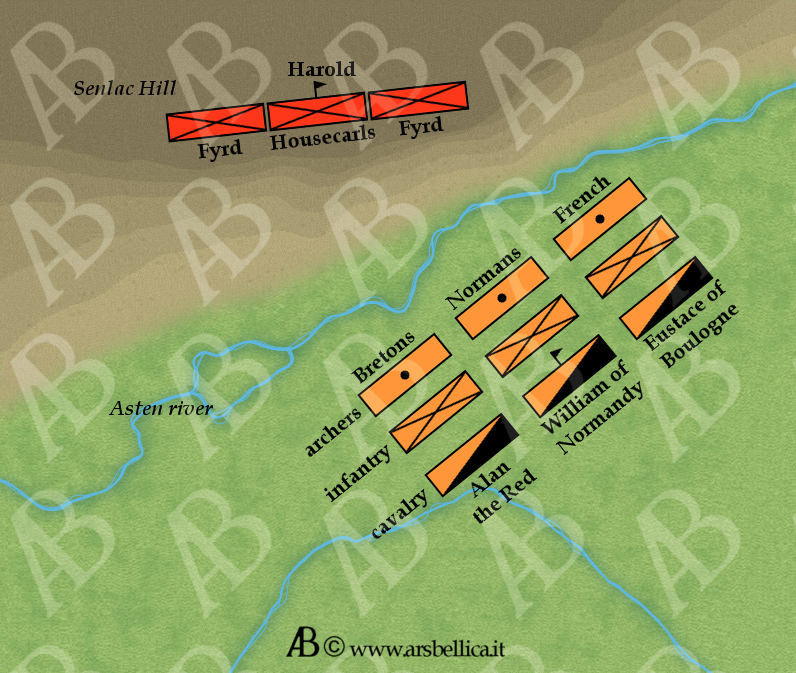
The attack of the Duke, who bore the Papal banner with him, was preceded by a compact arrows throwing from the archers placed in the first row, hurtle from the bottom upwards, causing few damages. Then the two wings enlarged, in an attempt to outflank the enemy, but due to the roughness of the terrain, the advance was too slow, and themselves became the object of a nourished javelins and axes throwing by the Saxons: wooden shields yielded under the violent blows as javelins and the axes penetrated the Norman's chainmail.

The Saxons then moved and attacked the left wing composed of Bretons, who, panicked and fled over the Norman army putting it in crisis, which was so forced to cede ground. Meanwhile was spreading the false news that William himself had died, which created even more disorder in Norman file: but in the most diffcult moment, the Duke emerged from a Scrum let be recognize by his men and screaming...'look at me, I'm still alive, and by the grace of God I will be winner».
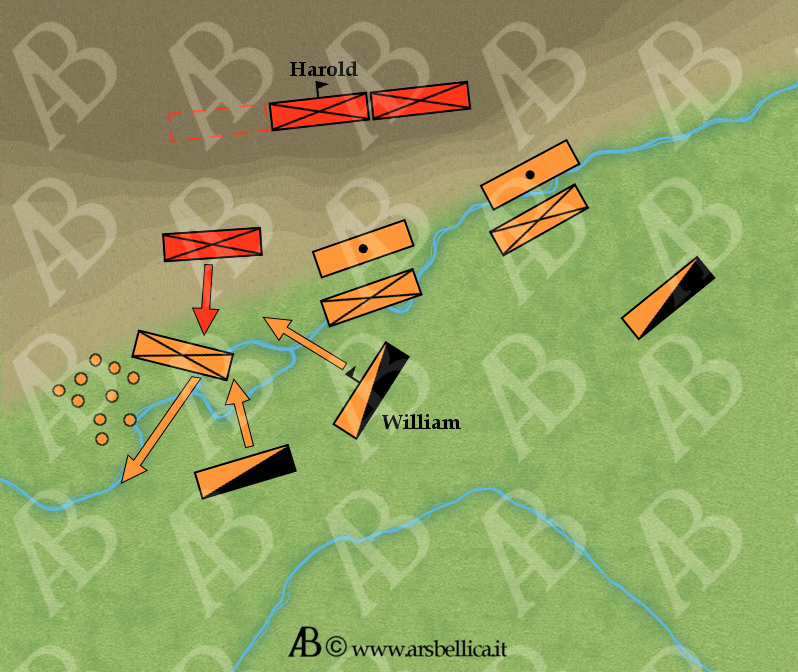
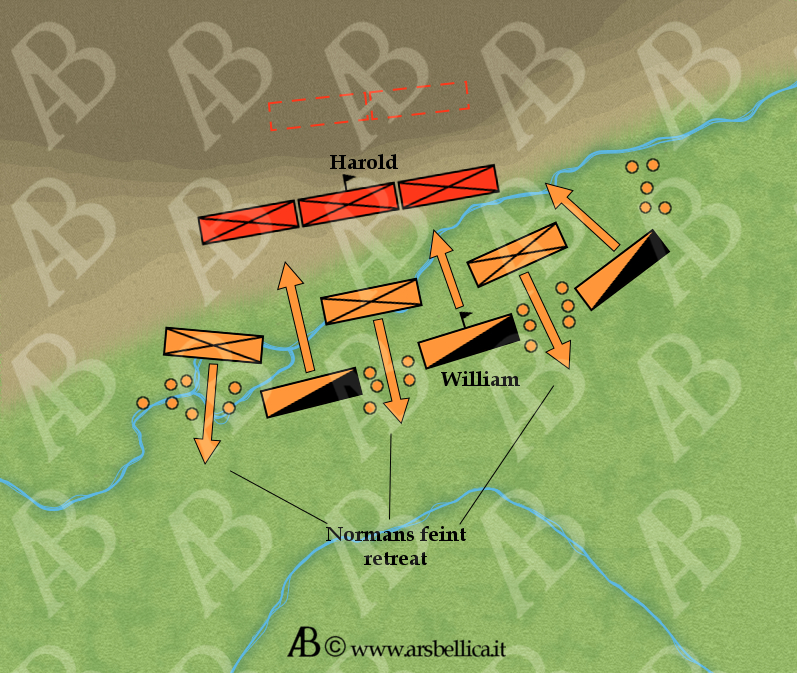
But the situation remained critical, the Normans were now fighting in disordered formations, while the Saxons were strong of their elevated position and mantained full compactness and solidity of the ranks. It was at this time that the Norman Duke had the idea that breakthrough the battle: order a feint retreat to his infantry, which was regularly pursued by the Saxons, that with this move losted perhaps their biggest advantage, the Hill on which they could not be attacked by the powerful Norman cavalry. These, as soon as they saw the Saxons moved in pursuit of the Norman infantry, charged hard the Saxon infantry slaughtering it. The first Saxon part that broken was the right wing of the leidang, which previously was disunited from the others as to attack the Bretons on the run. In the attempt of "rescue" this unit, Harold, was almost immediately hit in one eye by a arrow and died. The Saxons were now left without commander and then were annihilated.
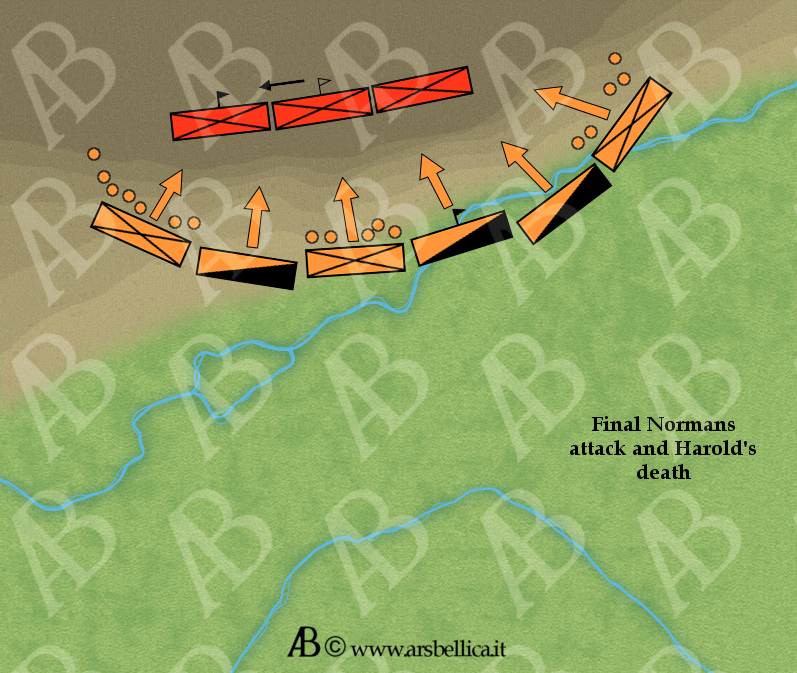
Harold's corpse was found by his rival, naked and so massacred by blows as to becoming unrecognizable, a fate that apparently was given to all the Saxons killed, as shown in the Bayeux Tapestry, which is certainly not lacking in gruesome scenes of deprivation and mutilation of corpses. William brought away from the battlefiled the corpse of the Saxon commander and later buried him on the beach.
HASTINGS
On Christmas day, at Westminster, William was crowned King of England: so began a long period of Norman domination on the island, but not only: considering the birthplace of the conquerors, it can be easily understand how until 1453 histories of France and England remained intertwined. It was created at particular situations; the English Kings from now onwards were owners of lands on both sides of the English channel, but not only, on one hand William was the King, on the other, as Dukes of a French territory, was vassals and feudatories (then theoretically "subjects") of the King of France!
At the death of the last descendant of William the Conqueror (Henry I) there were various struggles for conquest of the English throne, on which he Henry II the Plantagenet, son of Matilda (direct heir of Henry I) and Geoffrey, count of Anjou. The Plantagenet marries Eleanor of Aquitaine, becoming at the same time Lord of one third of the French territories. This situation was so unusual that it could only end up with a war, known as the "hundred years war"(1337-1453), which ended with the victory of the French, and that leaving, in the hands of the English, just the stronghold of Calais. The British island rulers, who had reigned on both the sides of the English channel, turn back to isolationist policy, which had been practiced by the Anglo-Saxon monarchs. This limited the rise of British power, which with the Tudor and their successors found in the seas and in their fleet a way to expansion and prosperity with trade, colonies and the naval power.
All this series of events would never have occurred if Harold won at Hastings. History would remember Norman expedition as one of the many invasions of a usurper who, once lost, would not have changed anything, but William's victory changed the whole history of Western Europe, and beyond.
HASTINGS
This painting is one of the most valuable historical sources concerning the Norman invasion into the British island; in reality it is a path with needlepoint wool yarn of different colors approximately 70 metres long and 50 cm wide.
There are represented 626 characters: 250 among horses and mules, 550 animals of all kinds, as well as castles, churches, ships, etc., for a total of 1500 figures. The work was probably finished between 1070 and 1077 custom perhaps Odo Bishop of Bayeux and half-brother of William the Conqueror, to narrate the conquest of England by the battle of Hastings. This tapestry depicts with great accuracy in all phases of the battle from the firsts until Harold's death, giving especially detailed depictions of used equipment and tactics followed in that historic battle.
Bibliography:
Livio Agostini, Piero Pastoretto, Le grandi Battaglie della Storia, Viviani Editore, Il Giornale, 1999